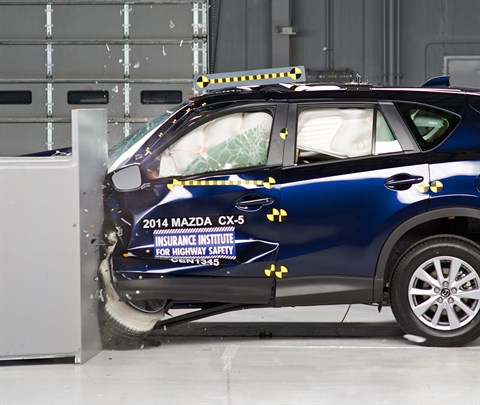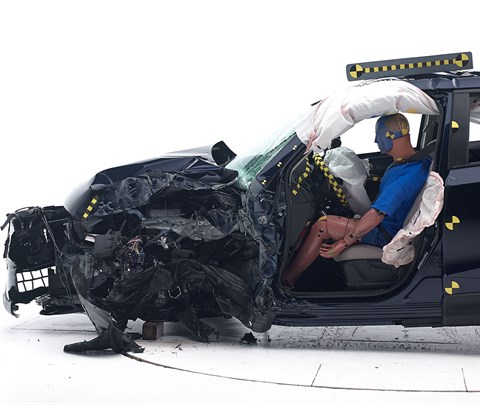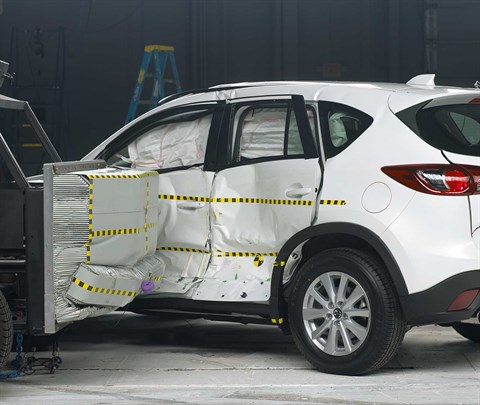Small overlap front: driver-side
Rating applies to 2014-16 models built after October 2013
Tested vehicle: 2014 Mazda CX-5 Sport 4-door 4wd
The Mazda CX-5 was introduced in the 2013 model year. Beginning with 2014 models built after October 2013, the front and side airbag programming and the front structure were modified to improve occupant protection in small overlap frontal crashes. (Information about when a specific vehicle was manufactured is on the certification label typically affixed to the car on the driver door or adjacent B-pillar.)
| Evaluation criteria | Rating |
|---|---|
| Structure and safety cage | |
| Driver injury measures | |
| Head/neck | |
| Chest | |
| Hip/thigh | |
| Lower leg/foot | |
| Driver restraints and dummy kinematics | |

Action shot taken during the small overlap frontal crash test.

The dummy's position in relation to the door frame, steering wheel, and instrument panel after the crash test indicates that the driver's survival space was maintained reasonably well.

The frontal and side curtain airbags worked well together to keep the head from coming close to any stiff structure or outside objects that could cause injury.

Intrusion into the driver's space was reasonably well controlled, and risk of injuries to the dummy's legs and feet was low.
Rating applies to 2013-14 models built before November 2013
Tested vehicle: 2013 Mazda CX-5 Sport 4-door 4wd
The Mazda CX-5 was introduced in the 2013 model year.
| Evaluation criteria | Rating |
|---|---|
| Structure and safety cage | |
| Driver injury measures | |
| Head/neck | |
| Chest | |
| Hip/thigh | |
| Lower leg/foot | |
| Driver restraints and dummy kinematics The dummy’s head contacted the frontal airbag but slid off the left side as the steering column moved 12 cm to the right, leaving the head vulnerable to contact with forward side structure. Additionally, the seat belt allowed excessive forward excursion of the dummy’s head and torso. The side curtain airbag deployed too late during the crash and does not have sufficient forward coverage to protect the head from contact with forward side structure and outside objects. | |

Action shot taken during the small overlap frontal crash test.

The dummy's position in relation to the door frame, steering wheel, and instrument panel after the crash test indicates that the driver's survival space wasn't maintained well.

The dummy’s head contacted the frontal airbag but then slid off the left side as the steering column moved to the right. The seat belt allowed the dummy to move too far forward, as is evident from the gap between the seat back and the dummy's torso. The side curtain airbag did not extend far enough forward toward the A-pillar.

Door hinge pillar and instrument panel intrusion was extensive and contributed to a moderate risk of injuries to the left knee and left lower leg.
Moderate overlap front: original test
Rating applies to 2013-16 models
Tested vehicle: 2013 Mazda CX-5 Sport 4-door 4wd
The Mazda CX-5 was introduced in the 2013 model year.
| Evaluation criteria | Rating |
|---|---|
| Overall evaluation | |
| Structure and safety cage | |
| Driver injury measures | |
| Head/neck | |
| Chest | |
| Leg/foot, left | |
| Leg/foot, right | |
| Driver restraints and dummy kinematics | |

Action shot taken during the frontal offset crash test.

The dummy's position in relation to the steering wheel and instrument panel after the crash test indicates that the driver's survival space was maintained very well.

Smeared greasepaint indicates where the dummy's head contacted the side curtain airbag, headliner, grab handle, and head restraint during rebound.

Intrusion into the driver's space was minimal, and all leg and foot injury measures were low.
Side: original test
Rating applies to 2013-16 models
Tested vehicle: 2013 Mazda CX-5 Sport 4-door 4wd with standard front and rear head curtain airbags and standard front seat-mounted torso airbags
The Mazda CX-5 was introduced in the 2013 model year.
| Evaluation criteria | Rating |
|---|---|
| Overall evaluation | |
| Structure and safety cage | |
| Driver injury measures | |
| Head/neck | |
| Torso | |
| Pelvis/leg | |
| Driver head protection | |
| Rear passenger injury measures | |
| Head/neck | |
| Torso | |
| Pelvis/leg | |
| Rear passenger head protection | |

View of the vehicle and barrier just after the crash test.

View of the vehicle after the crash with doors removed, showing the side airbags and damage to the occupant compartment.

Smeared greasepaint shows where the driver dummy's head was protected from being hit by hard structures by the side curtain airbag.

Smeared greasepaint shows where the rear passenger dummy’s head was protected by the side airbag.
Roof strength
Rating applies to 2013-16 models
Tested vehicle: 2013 Mazda CX-5 Sport 4-door 4wd
| Overall evaluation | |
|---|---|
| Curb weight | 3,330 lbs |
| Peak force | 18,209 lbs |
| Strength-to-weight ratio | 5.47 |
Head restraints & seats
Seat type: Manual cloth seats
| Overall evaluation | |
|---|---|
| Dynamic rating | |
| Seat/head restraint geometry |
About the head restraint & seat test
Currently, IIHS tests apply only to front seats.
